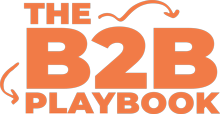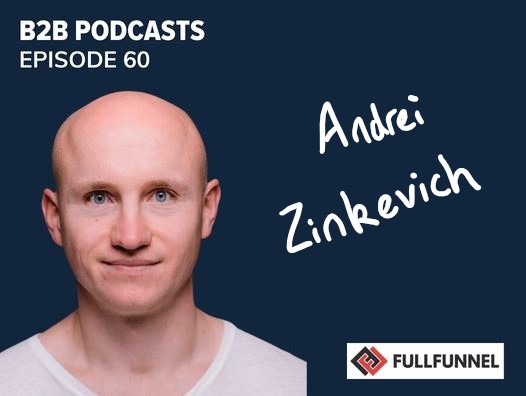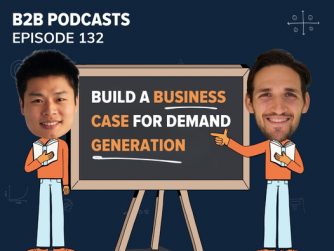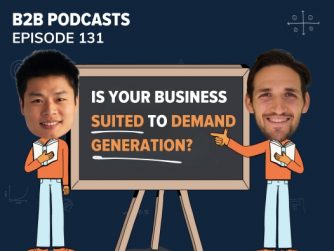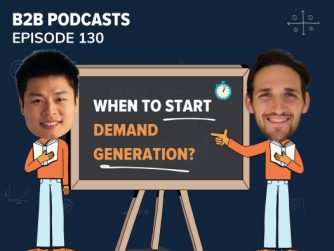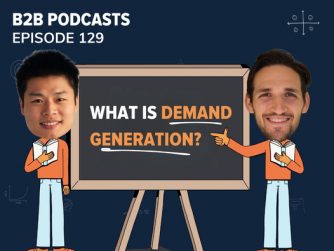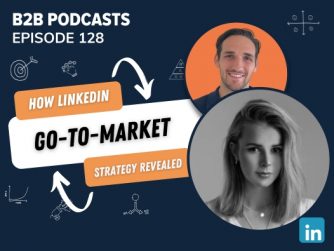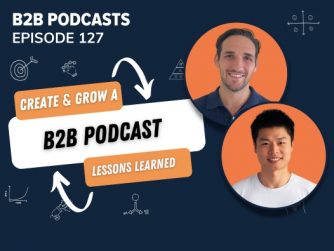This week we’re talking with Andrei Zinkevich.
This week we’re talking with Andrei Zinkevich. He’s the co-founder of Fullfunnel.io. Fullfunnel helps B2B Tech and Service-based companies generate demand and land mid-market and enterprise sales-qualified opportunities with full-funnel account-based marketing.
He takes us through some common B2B marketing mistakes that you will definitely be familiar with, and some awesome things you can do to save the pain and make the right calls in your B2B marketing!
Andrei has particular experience in the ABM stage and the steps leading up to ABM in marketing. So that’s why we’re stoked to have him on now to further contextualise how to get the most out of your ABM.
Links To Mentioned Resources:
Diagram of the full funnel approach
Some Highlights From The Episode
Some Of Andrei’s Key Points
- ABM and demand generation are both part of the same marketing brand journey. The goal of both is to create an engagement with certain accounts that builds more and more over time until they become a loyal customer.
- Start from creating awareness, tracking attention of target accounts, to activating and expanding your target accounts. That’s the full funnel.
- The problem is companies love short cuts. So before building a relationship, they go straight to sales after the first interaction. Demand generation and ABM both play an important role in developing relationships with these target accounts before they enter into the sales process so that accounts are much more engaged by that time.
- The full funnel process has to start with building awareness. It’s likely that businesses are not ready to buy from you. One display ad interaction is not enough to meet that awareness bar.
- Once you have awareness, you have to generate demand for your product or service. Only then can you turn to demand capture and activation.
- Client success is a stage that follows that a lot of businesses miss as well. This is very important that people miss. It’s about making sure the power users within a client’s business are onboard and using the product or service, getting value from the product or service quickly, so they retain and will renew their contracts the next time round. It’s not just about getting a review or case study. Those will come naturally when clients are getting product value and become your best customers ONGOING. It’s also the minimum bar to meet before you can think about upsell and expand the existing client’s deals.
- Common B2B Marketing mistakes:
- ABM does not equal display ads only! People spend most of their time, not on where display ads can be shown, but on CRMs, Google Sheets, Slack, Emails. You can’t reach people in those spaces.
- The same is true for one to many ABM, which is just not possible. It’s a shortcut that doesn’t work. You need to focus on a select few accounts that’ve been carefully screened for a high probability of interest of your product. And you need sufficient resources to target each one in turn. At least 4 people per enterprise account.
- “Educational” presentations / webinars that are really just a product pitch. These don’t work because no one likes this.
- The same is true for gated ebooks. There’s no correlation between downloads and purchase intent. If they are really interested, it’s not that hard to request a demo.
- Generic social sharing of company updates about the company, with no value for buyers. But at the same time asking for people to purchase.
- Instead these people should be nurtured, by you learning more about them and then helping them with their pain points through your content.
- What approaches can you take to really build demand:
- Start understanding and talking about topics or pain points your potential customers really care about.
- Talk to your potential customers to do creative thought leadership. Figure out what can actually get their attention and then educate them about a problem they didn’t even know existed. This is more often the stage they’re at. You can co-operate with small organisations and groups to test these thought leadership sharing sessions to have the most impact and learnings.
- Partner with credible associations / thought leaders, and deliver research or insights together to joint audiences with co-created content. This shares credibility, audiences, and content creation load. It will help everyone to start building relationships with potential customers. This is much more effective than cold outreach.
- How to figure out brands to target as part of ABM following demand generation work and get started:
- Most of the time you can use website traffic identification software, like Clearbit. And combine this with your data about what pages were visited, like through Google Analytics. You can use this as the starting point to meet the engagement threshold to nurture that audience.
- Someone should then go through account qualification analysis: location, revenue, company needs, resource needs etc. But be sure to also think generally about what might disqualify accounts that are not listed. E.g. if the company has undergone recent structural / personnel changes or hasn’t changed much for a long time, then it’s unlikely that they’re willing to make a change.
- Then do extensive account research to figure out as much as possible about what the business and the buying committee people individually care about. Build a full business case for every one of these individuals and levels of conversation.
- Do warm up campaigns, such as content collaboration, social engagement, small format events, and maybe remarketing if they’re already fairly engaged (with case studies etc). The goal is to have human interactions that allow you to validate they’re a good fit and have the pain points you can solve.
- Then share practical ways for them to get value and help from you. This starts to build relationships and allow you to get a conversation with other people on the buying committee. You need to arm champions with points to sell your brand in house. Don’t just share what they’re doing wrong. It’s about showing what else they can do and the benefits.
- You have to do this detailed approach. Which limits you to a handful of dream customers to go after at a time with ABM.
- Marketing’s role never stops. They should work in parallel with sales processes. Marketing needs to continue to help with collateral and passing on content and insights to support sales conversations which are aligned to earlier conversations to support as much as possible to the sales team. The two need to work together in an ongoing manner.
- Challenges: the mindset of potential dream customers is very important and often decides if they’re the right people to focus on in ABM.
- Lead gen mindset
- Everything should eventually be tied to revenue, but if you’re running what is inherently awareness or nurture campaigns, it’s not about generating leads or revenue. It should be about measuring awareness or engagement.
- Scalability obsession: usually caused by investor pressure or impatience. This short term focus kills marketing effectiveness.
- Not realistic about limitations – whether it’s limitations about resources, expertise, product, or skillset. You need to have the resources to be able to do the work, the product must be the leading product, and/or you have the skillset to improve the product or marketing.
- For small teams, B2B marketing means you need to be doing 80/20 analysis and really using it to focus on the things that work best and double down on them.
- It’s sad to see the diminished role of marketing, often taking orders from sales only. It’s completely different from sales, and you need to create demand. The bigger the price tag, the harder it is for sales, and the more important it is to trust in the marketing process over the long term. You need to excel at not losing your dignity as a B2B marketer. Understand and stick to explaining the marketing demand generation process. Explaining that the results come 12 months + from now. That’s the hard part of the job. Companies need to commit this so marketing can make the magic happen for the business as a whole and start generating more revenue than sales.
Sign up to our newsletter for the latest news and summary of the best content.
If you enjoy the podcast. Would you kindly consider leaving a short review? It takes only a minute and helps make a big difference in getting those amazing guests! We also love getting your insights by reading the reviews!
